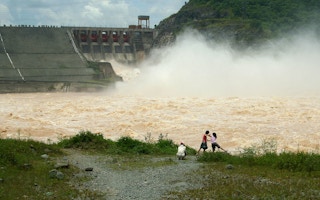Dozens of hydropower stations across Asia that were built decades ago are in need of multi-billion dollar investments to sustain their contribution to the region’s renewable energy goals, new research has found.
To continue reading, subscribe to Eco‑Business.
There's something for everyone. We offer a range of subscription plans.
- Access our stories and receive our Insights Weekly newsletter with the free EB Member plan.
- Unlock unlimited access to our content and archive with EB Circle.
- Publish your content with EB Premium.
The analysis, conducted by the International Hydropower Association for the Asian Infrastructure Investment Bank (AIIB), identifies 21 hydroelectric plants boasting a capacity of more than 6 gigawatts (GW) that urgently require an upgrade due to poor performance, equipment deficiencies and major failings in their civil infrastructure, with $2.7 billion in investment needed.
In addition, a further 45 stations with a capacity of nearly 20 GW are deemed to be ripe for rehabilitation in the coming years, representing up to $11 billion in financing needs. With 11 stations identified, India has the most hydropower plants assessed as being in high need of refurbishment, but several ageing structures are also sited in Russia, Turkey, Vietnam, Indonesia, Laos, and the Philippines, among others.
Like other infrastructure, hydropower facilities age over time, causing their reliability, output and safety to decline. Turbines, for instance, are subject to mechanical wear and tear, electrical generators slowly deteriorate from thermal stress, and dam structures degrade.
Overall, the study estimates that over one-third of the existing hydropower fleet across the energy-hungry continent will have undergone, or be due for, modernisation by 2030.
Hydropower accounts for about 14 per cent of total annual electricity generation in Asia, which is home to around half the world’s installed hydropower capacity. From Nepal to Laos, nations have placed big bets on hydroelectric dams to increase energy access and spur economic growth, with dozens of new projects in the pipeline.
But while much attention has been paid to scaling up new development, there is a growing need to optimise existing assets to enhance their safety and output while extending their lifespan, reads the study. In the past, poor maintenance and a disregard for safety concerns have resulted in dam collapses and other catastrophic accidents in countries like Laos, India and Russia.
Reduced performance over time can also lead to shortfalls in power supply, which not only pose perils for businesses but also often lead countries to install expensive and polluting thermal alternatives, such as coal-fired power plants.
Nicholas Troja, senior analyst at the International Hydropower Association, said: “Over the coming decade, the region’s need for reliable and sustainable energy will grow immensely. If properly managed and invested in strategically, hydropower’s existing capacity will form the backbone of this energy transition and be essential in meeting the objectives set out in both the Paris Agreement and the Sustainable Development Goals.”
Ways to refurbish existing facilities include retrofitting ageing turbines and other equipment with state-of-the-art technology and improving operations through new smart controls, intelligent condition monitoring and remotely operated systems.
Another option is to add floating solar farms to hydropower reservoirs to save on land and grid connection costs. Estimates put the generation capacity that floating photovoltaic panels could provide if deployed on reservoirs globally at a whopping 4,400 GW.
Rejuvenating old facilities has been shown to boost generation efficiency by up to 6 per cent, while replacing faulty equipment has enabled plant operators to recover one-third of total capacity. And as climate change kicks into higher gear in the years ahead, there will also be a need to install better flood defences and early warning systems to prepare hydropower stations in climate-vulnerable Asia for increasingly intense weather events, reads the report.
The study warns that in the absence of modernisation efforts, governments risk having to decommission ageing stations and losing reliable, clean electricity generation capacity. Steady green power supply grows ever more important as variable renewables like solar and wind energy, whose output fluctuates depending on weather patterns, gain traction on Asia’s energy scene.
While emissions-free, hydropower has not been without controversy. Around the globe, hydroelectric ventures have wiped out riverine ecosystems, displaced communities and wrecked livelihoods, often leading to social conflict. A 2019 report by non-governmental organisation Global Witness found that of the 164 environment and land defenders killed in 2018, 17 lost their lives protesting against dam projects.








